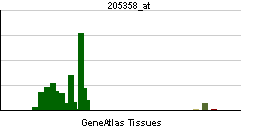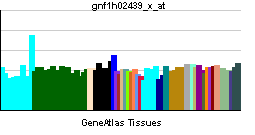GRIA2
Glutamate receptor, ionotropic, AMPA 2, also known as GRIA2, is a human gene.[1]
Glutamate receptors are the predominant excitatory neurotransmitter receptors in the mammalian brain and are activated in a variety of normal neurophysiologic processes. This gene product belongs to a family of glutamate receptors that are sensitive to alpha-amino-3-hydroxy-5-methyl-4-isoxazole propionate (AMPA), and function as ligand-activated cation channels. These channels are assembled from 4 related subunits, GRIA1-4. The subunit encoded by this gene (GRIA2) is subject to RNA editing (CAG->CGG; Q->R) within the second transmembrane domain, which is thought to render the channel impermeable to Ca(2+). Human and animal studies suggest that pre-mRNA editing is essential for brain function, and defective GRIA2 RNA editing at the Q/R site may be relevant to amyotrophic lateral sclerosis (ALS) etiology. Alternative splicing, resulting in transcript variants encoding different isoforms, has been noted for this gene, which includes the generation of flip and flop isoforms that vary in their signal transduction properties.[1]
See also
References
Further reading
- Soundarapandian MM, Tu WH, Peng PL; et al. (2007). "AMPA receptor subunit GluR2 gates injurious signals in ischemic stroke". Mol. Neurobiol. 32 (2): 145–55. PMID 16215279.
- Sun W, Ferrer-Montiel AV, Schinder AF; et al. (1992). "Molecular cloning, chromosomal mapping, and functional expression of human brain glutamate receptors". Proc. Natl. Acad. Sci. U.S.A. 89 (4): 1443–7. PMID 1311100.
- McNamara JO, Eubanks JH, McPherson JD; et al. (1992). "Chromosomal localization of human glutamate receptor genes". J. Neurosci. 12 (7): 2555–62. PMID 1319477.
- Sommer B, Keinänen K, Verdoorn TA; et al. (1990). "Flip and flop: a cell-specific functional switch in glutamate-operated channels of the CNS". Science. 249 (4976): 1580–5. PMID 1699275.
- Sommer B, Köhler M, Sprengel R, Seeburg PH (1991). "RNA editing in brain controls a determinant of ion flow in glutamate-gated channels". Cell. 67 (1): 11–9. PMID 1717158.
- Paschen W, Hedreen JC, Ross CA (1994). "RNA editing of the glutamate receptor subunits GluR2 and GluR6 in human brain tissue". J. Neurochem. 63 (5): 1596–602. PMID 7523595.
- Köhler M, Kornau HC, Seeburg PH (1994). "The organization of the gene for the functionally dominant alpha-amino-3-hydroxy-5-methylisoxazole-4-propionic acid receptor subunit GluR-B". J. Biol. Chem. 269 (26): 17367–70. PMID 7545935.
- Eastwood SL, Burnet PW, Beckwith J; et al. (1994). "AMPA glutamate receptors and their flip and flop mRNAs in human hippocampus". Neuroreport. 5 (11): 1325–8. PMID 7919190.
- Sun W, Ferrer-Montiel AV, Montal M (1994). "Primary structure and functional expression of the AMPA/kainate receptor subunit 2 from human brain". Neuroreport. 5 (4): 441–4. PMID 8003671.
- Higuchi M, Single FN, Köhler M; et al. (1994). "RNA editing of AMPA receptor subunit GluR-B: a base-paired intron-exon structure determines position and efficiency". Cell. 75 (7): 1361–70. PMID 8269514.
- McLaughlin DP, Cheetham ME, Kerwin RW (1993). "Expression of alternatively-spliced glutamate receptors in human hippocampus". Eur. J. Pharmacol. 244 (1): 89–92. PMID 8420792.
- Srivastava S, Osten P, Vilim FS; et al. (1998). "Novel anchorage of GluR2/3 to the postsynaptic density by the AMPA receptor-binding protein ABP". Neuron. 21 (3): 581–91. PMID 9768844.
- Matsuda S, Mikawa S, Hirai H (1999). "Phosphorylation of serine-880 in GluR2 by protein kinase C prevents its C terminus from binding with glutamate receptor-interacting protein". J. Neurochem. 73 (4): 1765–8. PMID 10501226.
- Hirai H, Matsuda S (2000). "Interaction of the C-terminal domain of delta glutamate receptor with spectrin in the dendritic spines of cultured Purkinje cells". Neurosci. Res. 34 (4): 281–7. PMID 10576550.
- Aruscavage PJ, Bass BL (2000). "A phylogenetic analysis reveals an unusual sequence conservation within introns involved in RNA editing". RNA. 6 (2): 257–69. PMID 10688364.
- Osten P, Khatri L, Perez JL; et al. (2000). "Mutagenesis reveals a role for ABP/GRIP binding to GluR2 in synaptic surface accumulation of the AMPA receptor". Neuron. 27 (2): 313–25. PMID 10985351.
- Chung HJ, Xia J, Scannevin RH; et al. (2001). "Phosphorylation of the AMPA receptor subunit GluR2 differentially regulates its interaction with PDZ domain-containing proteins". J. Neurosci. 20 (19): 7258–67. PMID 11007883.
- Armstrong N, Gouaux E (2000). "Mechanisms for activation and antagonism of an AMPA-sensitive glutamate receptor: crystal structures of the GluR2 ligand binding core". Neuron. 28 (1): 165–81. PMID 11086992.
- Krampfl K, Schlesinger F, Zörner A; et al. (2002). "Control of kinetic properties of GluR2 flop AMPA-type channels: impact of R/G nuclear editing". Eur. J. Neurosci. 15 (1): 51–62. PMID 11860506.
- Hirbec H, Perestenko O, Nishimune A; et al. (2002). "The PDZ proteins PICK1, GRIP, and syntenin bind multiple glutamate receptor subtypes. Analysis of PDZ binding motifs". J. Biol. Chem. 277 (18): 15221–4. doi:10.1074/jbc.C200112200. PMID 11891216.
External links
- GRIA2+protein,+human at the US National Library of Medicine Medical Subject Headings (MeSH)
| Stub icon | This membrane protein–related article is a stub. You can help Wikipedia by expanding it. |
This article incorporates text from the United States National Library of Medicine, which is in the public domain.



